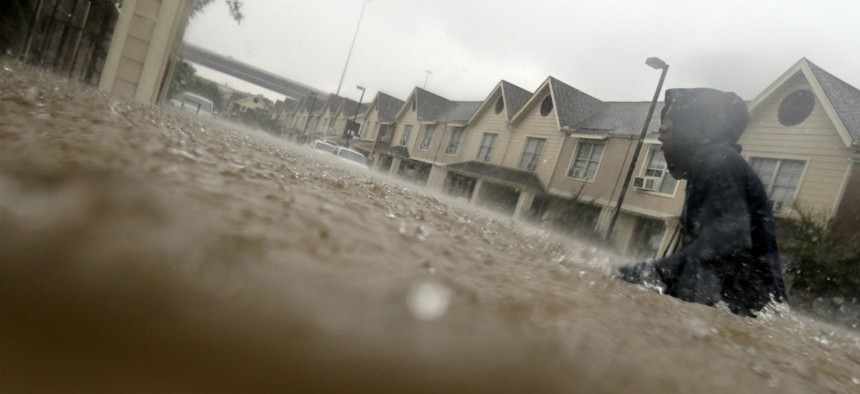
A child makes his way through floodwaters from Tropical Storm Harvey in Houston on Aug. 27, 2017. LM Otero/AP
Nearly 60,000 Feds Impacted by Harvey
The Office of Personnel Management is coordinating with local federal executive boards to keep employees informed.
The Office of Personnel Management said Monday that 59,600 federal employees from 45 agencies work in the region impacted by Hurricane Harvey, which struck Texas over the weekend. OPM is coordinating its response with local federal executive boards.
Harvey made landfall northeast of Corpus Christi, Texas, late Friday as a category 4 hurricane before moving north to Houston, dumping torrential rain across a wide area and causing massive flooding. Although Harvey was downgraded to a tropical storm on Sunday, heavy rainfall pounded the area throughout the weekend and is forecast to continue for days.
Acting OPM Director Kathleen McGettigan issued a memo to federal agencies Sunday requesting information about severely affected employees within the hurricane’s path who may need assistance through the Emergency Leave Transfer Program, which allows federal employees elsewhere to donate unused leave to those in need. And she highlighted agencies’ ability to make 30-day emergency appointments for critical jobs, as well as the posts that agencies can fill through direct hire authority, such as medical officers, nurses and federal acquisition positions.
An OPM spokesperson said the agency is working closely with Houston and San Antonio’s federal executive boards to answer human resources questions for affected agencies and employees.
“We are also contacting agency headquarters with employees in affected counties to determine the number of employees who are experiencing severe adverse effects from this emergency in order to assess the need to establish an emergency leave transfer program,” the spokesperson said.
LeAnn Jenkins, acting executive director for the Federal Executive Board in Houston, said that so far, her office has been focused on sharing important information with employees and federal agencies.
“It’s still pretty early, and [feds] are running into the same thing everyone else is running into, and that’s high water,” she said. “Right now, we’re sending mostly emergency notifications to agency heads to send to their employees, information that the airports are still closed and that all critical water rescues are expected to be completed today.”
Jenkins said her work so far has been distributing a mix of vital safety information, such as alerts from the National Weather Service, or information about where people can go to pick up their cars if they were towed before streets flooded. Additionally, she said FEB has been attempting to make sure individuals’ calls for assistance make it to safety officials.
“We’re so tuned into social media right now, and letting people know that if you’re in the second story of your house and you posted on Facebook that your house is flooded, the rescue workers don’t get that information,” Jenkins said. “Just because you tweet it doesn’t mean they get it, so you need to call 911 or one of these five [U.S.] Coast Guard command center phone numbers. That’s something that was unanticipated, and so we’re just trying to keep up with these things as they come up.”
Jenkins' comments echoed a tweet from the Coast Guard highlighting its Houston command center phone numbers and encouraging people to contact them, rather than post on social media.







